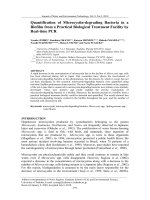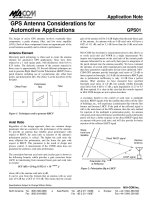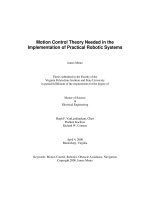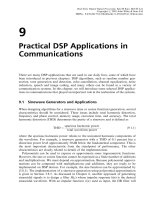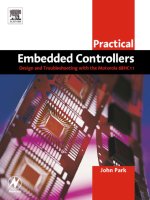Practical Considerations
Bạn đang xem bản rút gọn của tài liệu. Xem và tải ngay bản đầy đủ của tài liệu tại đây (1.1 MB, 49 trang )
115
Analytical Electrochemistry, Third Edition, by Joseph Wang
Copyright © 2006 John Wiley & Sons, Inc.
4
PRACTICAL CONSIDERATIONS
The basic instrumentation required for controlled-potential experiments is
relatively inexpensive and readily available commercially. The basic necessi-
ties include a cell (with a three-electrode system), a voltammetric analyzer
(consisting of a potentiostatic circuitry and a voltage ramp generator), and a
plotter. Modern voltammetric analyzers are versatile enough to perform many
modes of operation. Depending on the specific experiment, other components
may be required. For example, a faradaic cage is desired for work with ultra-
microelectrodes.The system should be located in a room free from major elec-
trical interferences, vibrations, and drastic fluctuations in temperature.
4.1 ELECTROCHEMICAL CELLS
Three-electrode cells (e.g., see Fig. 4.1) are commonly used in controlled-
potential experiments.The cell is usually a covered beaker of 5–50 mL volume,
and contains the three electrodes (working, reference, and auxiliary), which
are immersed in the sample solution. While the working electrode is the elec-
trode at which the reaction of interest occurs, the reference electrode provides
a stable and reproducible potential (independent of the sample composition),
against which the potential of the working electrode is compared. Such
“buffering” against potential changes is achieved by a constant composition
of both forms of its redox couple, such as Ag/AgCl or Hg/Hg
2
Cl
2
, as common
with the silver–silver chloride and the saturated calomel reference electrodes,
respectively. To minimize contamination of the sample solution, the reference
electrode may be insulated from the sample through an intermediate bridge.
An inert conducting material, such as platinum wire or graphite rod, is usually
used as the current-carrying auxiliary electrode. The relative position of these
electrodes and their proper connection to the electrochemical analyzer should
be noted (see Section 4.4). The three electrodes, as well as the tube used for
bubbling the deoxygenating gas (see Section 4.3), are supported in five holes
in the cell cover. Complete systems, integrating the three-electrode cell, built-
in gas control, and magnetic stirrer, along with proper cover, are available com-
mercially (e.g., see Fig. 4.2).
The exact cell design and the material used for its construction are selected
according to the experiment at hand and the nature of the sample. The various
designs differ with respect to size, temperature control capability, stirring
requirement, shape, or number of cell compartments. Various microcells with
20–500 µL volumes can be used when the sample volume is limited. Particu-
larly attractive are thin-layer cells in which the entire sample is confined within
116
PRACTICAL CONSIDERATIONS
CE
WE
RE
N
2
Figure 4.1 Schematic diagram of a cell for voltammetric measurements: WE—
working electrodes; RE—reference electrode; CE—counter electrode. The electrodes
are inserted through holes in the cell cover.
a thin layer (of less than 10 µm thickness) at the electrode surface (1). Smaller
sample volumes can be accommodated in connection with ultramicroelec-
trodes (discussed in Section 4.4) and advanced microfabrication processes
(discussed in Section 6.3). In particular, lithographically fabricated picoliter
microvials (2) hold great promise for assays of ultrasmall environments (e.g.,
single-cell systems). Specially designed flow cells (discussed in Section 3.6) are
used for on-line applications. Glass is commonly used as the cell material, due
to its low cost, transparency, chemical inertness, and impermeability.Teflon and
quartz represent other possible cell materials. The cell cover can be con-
structed of any suitable material that is inert to the sample. An accurate tem-
perature control is readily achieved by immersing or jacketing the cell in a
constant-temperature bath.
4.2 SOLVENTS AND SUPPORTING ELECTROLYTES
Electrochemical measurements are commonly carried out in a medium that
consists of solvent containing a supporting electrolyte. The choice of solvent
is dictated primarily by the solubility of the analyte and its redox activity, and
by solvent properties, such as the electrical conductivity, electrochemical activ-
ity, and chemical reactivity. The solvent should not react with the analyte (or
products) and should not undergo electrochemical reactions over a wide
potential range.
While water has been used as a solvent more than any other medium, non-
aqueous solvents [e.g., acetonitrile, propylene carbonate, dimethylformamide
SOLVENTS AND SUPPORTING ELECTROLYTES
117
Figure 4.2 A complete cell stand. (Courtesy of BAS Inc.)
(DMF), dimethylsulfoxide (DMSO), or methanol] have also frequently
been used. Mixed solvents may also be considered for certain applications.
Double-distilled water is adequate for most work in aqueous media.
Triple-distilled water is often required when trace (stripping) analysis is con-
cerned. Organic solvents often require a drying or purification procedure.
These and other solvent-related considerations have been reviewed by Mann
(3).
Supporting electrolytes are required in controlled-potential experiments to
decrease the resistance of the solution, eliminate electromigration effects, and
maintain a constant ionic strength (i.e., “swamping out” the effect of variable
amounts of naturally occurring electrolyte) (4). The inert supporting elec-
trolyte may be an inorganic salt, a mineral acid, or a buffer. While potassium
chloride or nitrate, ammonium chloride, sodium hydroxide, or hydrochloric
acid are widely used when water is employed as a solvent, tetraalkylammo-
nium salts are often employed in organic media. Buffer systems (such as
acetate, phosphate, or citrate) are used when a pH control is essential. The
composition of the electrolyte may affect the selectivity of voltammetric meas-
urements. For example, the tendency of most electrolytes to complex metal
ions can benefit the analysis of mixtures of metals. In addition, masking agents
[such as ethylenediaminetetraacetic acid (EDTA)] may be added to “remove”
undesired interferences. The supporting electrolyte should be prepared from
highly purified reagents, and should not be easily oxidized or reduced (hence
minimizing potential contamination or background contributions, respec-
tively). The usual electrolyte concentration range is 0.1–1.0M, i.e., in large
excess of the concentration of all electroactive species. Significantly lower
levels can be employed in connection with ultramicroscale working electrodes
(see Section 4.5.4).
4.3 OXYGEN REMOVAL
The electrochemical reduction of oxygen usually proceeds via two well-
separated two-electron steps. The first step corresponds to the formation of
hydrogen peroxide
(4.1)
and the second step corresponds to the reduction of the peroxide:
(4.2)
The half-wave potentials of these steps are approximately −0.1 and −0.9 V (vs.
the saturated calomel electrode). The exact stoichiometry of these steps is
dependent on the medium. The large background current accrued from this
stepwise oxygen reduction interferes with the measurement of many reducible
HO H e HO
22 2
222++→
+−
OHeHO
222
22++→
+−
118
PRACTICAL CONSIDERATIONS
analytes. In addition, the products of the oxygen reduction may affect the elec-
trochemical process under investigation.
A variety of methods have thus been used for the removal of dissolved
oxygen (5). The most common method has been purging with an inert gas
(usually purified nitrogen) for 4–8min prior to recording of the voltammo-
gram. Longer purge times may be required for large sample volumes or for
trace measurements. To prevent oxygen from reentering, the cell should be
blanketed with the gas while the voltammogram is being recorded. Passage of
the gas through a water-containing presaturator is desired to avoid evapora-
tion. The deaeration step, although time-consuming, is quite effective and suit-
able for batch analysis. (The only exception is work with microsamples, where
deoxygenation may lead to errors caused by the evaporation of solvent or loss
of volatile compounds.)
Other methods have been developed for the removal of oxygen (particu-
larly from flowing streams). These include the use of electrochemical or chem-
ical (zinc) scrubbers, nitrogen-activated nebulizers, and chemical reduction (by
addition of sodium sulfite or ascorbic acid). Alternately, it may be useful to
employ voltammetric methods that are less prone to oxygen interference. The
background-correction capability of modern (computerized) instruments is
also effective for work in the presence of dissolved oxygen.
4.4 INSTRUMENTATION
Rapid advances in microelectronics, and in particular the introduction of oper-
ational amplifiers, have led to major changes in electroanalytical instrumen-
tation. Tiny and inexpensive integrated circuits can now perform many
functions that previously required very large instruments. Such trends have
been reviewed (6). Various voltammetric analyzers are now available com-
mercially from different sources (Table 4.1) at relatively modest prices
[ranging from $5000 to $25,000 (in 2005)]. Such instruments consist of two cir-
cuits: a polarizing circuit that applies the potential to the cell, and a measur-
ing circuit that monitors the cell current. The characteristic of modern
voltammetric analyzers is the potentiostatic control of the working electrode,
which minimizes errors due to cell resistance (i.e., poorly defined voltammo-
grams with lower current response and shifted and broadened peaks). Equa-
tion 4.3 explains the cause for this ohmic distortion:
(4.3)
where iR is the ohmic potential drop.
The potentiostatic control, aimed at compensating a major fraction of the
cell resistance, is accomplished with a three-electrode system and a combina-
tion of operational amplifiers and feedback loops (Fig. 4.3). Here, the refer-
ence electrode is placed as close as possible to the working electrode and
EEEiR
app WE RE
=−−
INSTRUMENTATION
119
120
PRACTICAL CONSIDERATIONS
TABLE 4.1 Current Suppliers of Voltammetric Analyzers
Supplier Address
Analytical Instrument Systems PO Box 458
Flemington, NJ 08822
www.aishome.com
Bioanalytical Systems 2701 Kent Ave.
W. Lafayette, IN 47906
www.bioanalytical.com
Cypress PO Box 3931
Lawrence, KS 66044
www.cypresshome.com
CH Instruments 3700 Tennison Hill Dr.
Austin, TX 78733
ECO Chemie PO Box 85163
3508 AD Utrecht
The Netherlands
www.brinkmann.com
EG&G PAR 801 S. Illinois Ave.
Oak Ridge, TN 37830
www.egg.inc.com/par
ESA 45 Wiggins Ave.
Bedford, MA 01730
Metrohm CH-9109 Herisau
Switzerland
www.brinkmann.com
Palm Instruments BV Ruitercamp 119
3993 BZ Houten
The Netherlands
www.palmsens.com
Radiometer/Tacussel 27 rue d’Alscace
F-69627 Villeurbanne
France
Solartron 964 Marcon Blvd.
Allentown, PA 18103, USA
www.solartron.com
TraceDetect Seattle, WA, USA
www.tracedetect.com
connected to the instrument through a high-resistance circuit that draws no
current from it. Because the flow cannot occur through the reference elec-
trode, a current-carrying auxiliary electrode is placed in the solution to com-
plete the current path. Hence, the current flows through the solution between
the working and the auxiliary electrodes. Symmetry in the placement of these
electrodes is important for the assumption that the current paths from all
points on the working electrode are equivalent. Because no current passes
through the reference electrode and because of its position close to the
working electrode, the potential drop caused by the cell resistance (iR) is min-
imized. If the potential sensed by the reference electrode is less than the
desired value, the operational amplifier control loop provides a corrective
potential. By adding an operational amplifier current-to-voltage converter
(called a “current follower”) to the working electrode, it is possible to measure
the current without disturbing the controlled parameters. The instrument also
includes a ramp generator to produce various regularly changing potential
waveforms.
As was pointed out earlier, an effective potential control requires a very
close proximity between the working and reference electrodes. This can be
accomplished by using a specially designed bridge of the reference electrode,
known as a Luggin probe. The tip of this bridge should be placed as close as
twice its diameter to the working electrode. A smaller distance will result in
blockage (shielding) of the current path and hence a nonhomogeneous current
density. The Luggin bridge should also not interfere to the convective trans-
port toward the surface of the working electrode.
It should be pointed out that not all of the iR drop is removed by the
potentiostatic control. Some fraction, denoted as iR
u
(where R
u
is the
uncompensated solution resistance between the reference and working
INSTRUMENTATION
121
E
app
Feedback
amplifier
Reference
electrode
Current
amplifier
Readout
Working electrode
Counter electrode
Scan
amplifier
Figure 4.3 Schematic diagram of a three-electrode potentiostat.
electrodes), will still be included in the measured potential. This component
may be significantly large when resistive nonaqueous media are used, and thus
may lead to severe distortion of the voltammetric reponse. Many modern
instruments, however, automatically subtract (compensate) the iR
u
drop
from the potential signal given to the potentiostat via an appropriate positive
feedback.
Biopotentiostats, offering simultaneous control of two working electrodes
(e.g., in ring–disk configuration) are also available. Such instruments consist
of a conventional potentiostat with a second voltage-control circuit. Multi-
potentiostats, controlling multiple working electrodes (connected to a multi-
plexed data acquisition circuitry), have also been described (7). The
development of ultramicroelectrodes, with their very small currents (and thus
negligible iR losses even when R is large), allows the use of simplified, two-
electrode, potential control (see Section 4.5.4). In contrast, ultramicroelec-
trode work requires an efficient current measurement circuitry to differentiate
between the faradaic response and the extraneous electronic noise and for
handling low currents down to the pA (picoampere) range. Other considera-
tions for noise reduction involve the grounding and shielding of the instru-
ment and cell.
The advent of inexpensive computing power has changed dramatically the
way voltammetric measurements are controlled and data are acquired and
manipulated. Computer-controlled instruments, available from most manu-
facturers (6), provide flexibility and sophistication in the execution of a great
variety of modes. In principle, any potential waveform that can be defined
mathematically can be applied with commands given through a keyboard.
Such instruments offer various data processing options, including autoranging,
blank subtraction, noise reduction, curve smoothing, differentiation, integra-
tion, and peak search. The entire voltammogram can be presented as a plot or
printout (of the current–potential values). In addition, computer control has
allowed automation of voltammetric experiments and hence has greatly
improved the speed and precision of the measurement. Since the electro-
chemical cell is an analog element, and computers work only in the digital
domain, analog-to-digital (A/D) and digital-to-analog (D/A) converters are
used to interface between the two. Unattended operation has been accom-
plished through the coupling of autosamplers and microprocessor-controlled
instruments (e.g., see Fig. 4.4). The autosampler can accommodate over 100
samples, as well as relevant standard solutions. Such coupling can also address
the preliminary stages of sample preparation (as dictated by the nature of the
sample). The role of computers in electroanalytical measurements and in the
development of “smarter” analyzers has been reviewed by Bond (8) and He
et al. (9).
The nature of electrochemical instruments makes them very attractive for
decentralized testing. For example, compact, battery-operated voltammetric
analyzers, developed for on-site measurements of metals (e.g., 10,11), readily
address the growing needs for field-based environmental studies and security
122
PRACTICAL CONSIDERATIONS
surveillance applications. Similarly, portable (hand-held) instruments are
being designed for decentralized clinical testing (12).
4.5 WORKING ELECTRODES
The performance of the voltammetric procedure is strongly influenced by the
working-electrode material.The working electrode should provide high signal-
to-noise characteristics, as well as a reproducible response. Thus, its selection
depends primarily on two factors: the redox behavior of the target analyte
and the background current over the potential region required for the meas-
urement. Other considerations include the potential window, electrical con-
ductivity, surface reproducibility, mechanical properties, cost, availability, and
toxicity.A range of materials have found application as working electrodes for
electroanalysis. The most popular are those involving mercury, carbon, or
noble metals (particularly platinum and gold). Figure 4.5 displays the accessi-
ble potential window of these electrodes in various solutions. The geometry of
these electrodes must also be considered.
4.5.1 Mercury Electrodes
Mercury is a very attractive choice for electrode materials because it has a
high hydrogen overvoltage that greatly extends the cathodic potential window
(compared to solid electrode materials) and possesses a highly reproducible,
readily renewable, and smooth surface. In electrochemical terms, its roughness
factor is equal to one (i.e., identical geometric and actual surface areas).
Disadvantages of the use of mercury are its limited anodic range (due to the
oxidation of mercury) and toxicity.
WORKING ELECTRODES
123
Figure 4.4 Microprocessor-controlled voltammetric analyzer, in connection with an
autosampler. (Courtesy of Metrohm Inc.)
There are several types of mercury electrodes. Of these, the dropping
mercury electrode (DME), the hanging mercury drop electrode (HMDE), and
the mercury film electrode (MFE) are the most frequently used. Related solid
amalgam electrodes have been introduced more recently to address concerns
related to the toxicity of mercury.
The DME, used in polarography (Section 3.2) and for electrocapillary
studies (Section 1.4), consists of a 12–20-cm-long glass capillary tubing (with
an internal diameter of 30–50 µm), connected by a flexible tube to an elevated
reservoir of mercury (Fig. 4.6). Electrical contact is effected through a wire
inserted into the mercury reservoir. Mercury flows by gravity through the cap-
illary at a steady rate, emerging from its tip as continuously growing drops. By
adjusting the height of the mercury column, one may vary the drop time; the
lifetime of the drop is typically 2–6s. Such continuous exposure of fresh spher-
ical drops eliminates passivation problems that may occur at stable solid elec-
trodes. The key to successful operation of the DME is proper maintenance of
its capillary (which prevents air bubbles, solution creeping, and dirt). More
elaborate DMEs, based on a mechanical drop detachment at reproducible
time intervals, are used for pulse polarography.
The hanging mercury drop electrode is a popular working electrode for
stripping analysis and cyclic voltammetry. In this configuration, stationary
mercury drops are displaced from a reservoir through a vertical capillary.
Early (Kemula-type) HMDE designs rely on a mechanical extrusion (by a
micrometer-driven syringe) from a reservoir through a capillary (13). The
mercury reservoir should be completely filled with mercury; air must be fully
eliminated. Modern HMDEs (particularly with the model 303 of EG&G PAR,
shown in Fig. 4.7) employ an electronic control of the drop formation, which
offers improved reproducibility and stability (14). For this purpose, a solenoid-
activated valve dispenses the mercury rapidly, and the drop size is controlled
124
PRACTICAL CONSIDERATIONS
Pt
Hg
C
+2 +1
Potential (V vs. SCE)
0
–1 –2
1 M H
2
SO
4
1 M H
2
SO
4
0.1 M Et
4
NOH
1 M HClO
4
0.1 M KCI
1 M NaOH
1 M NaOH
1 M KCl
Figure 4.5 Accessible potential window of platinum, mercury, and carbon electrodes
in various supporting electrolytes.
by the time during which the valve is opened. A wide-bore capillary allows a
mercury drop to be grown very rapidly when the valve is opened. Three valve
opening times produce drops that are described as small, medium, or large.
Since the potential scan is accomplished after the valve has been closed (i.e.,
stationary electrode), charging-current contributions due to the drop growth
are eliminated. All the components of this electrode, including the mercury
reservoir, are contained in a compact unit. Such a commercial probe allows
the conversion from the HMDE to DME by a single switch. When used in the
DME mode, it exhibits a very rapid growth to a given area, which then remains
constant (as desired for minimizing charging-current contributions). The per-
formance of HMDEs can be improved by siliconizing the interior bore of the
capillary.
WORKING ELECTRODES
125
<1 mm
Reference
electrode
Auxiliary
electrode
Clamp
Hg reservoir
Electrical
contact
Figure 4.6 The dropping mercury electrode.
Several mercury electrodes combine the features of the DME and HMDE.
In particular, one employs a narrow-bore capillary that produces DMEs with
drop lifetimes of 50–70s (15). The other involves a controlled growth mercury
drop (16). For this purpose, a fast-response valve offers a wide range of drop
sizes and a slowly (step-by-step) growing drop.
The mercury film electrode (MFE), used for stripping analysis or flow
amperometry, consists of a very thin (10–100-µm) layer of mercury covering
a conducting and inert support. Because of the adherent oxide films on metal
surfaces, and the interaction of metals with mercury, glassy carbon is most
often used as a substrate for the MFE. The mercury film formed on a glassy
carbon support is actually composed of many droplets. Because they do not
126
PRACTICAL CONSIDERATIONS
Figure 4.7 The static mercury drop electrode and its cell stand.
have a pure mercury surface, such film electrodes exhibit a lower hydrogen
overvoltage and higher background currents. Another useful substrate for the
MFE is iridium (because of its very low solubility in mercury and the excel-
lent adherence of the resulting film). Mercury film electrodes are commonly
preplated by cathodic deposition from a mercuric nitrate solution. An in situ
plated MFE is often employed during stripping analysis (17). This electrode is
prepared by simultaneous deposition of the mercury and the measured metals.
Most commonly, a disk-shaped carbon electrode is used to support the
mercury film. Mercury film ultramicroelectrodes, based on coverage of carbon
fiber or carbon microdisk surfaces, have also received a growing attention in
recent years.
4.5.2 Solid Electrodes
The limited anodic potential range of mercury electrodes has precluded their
utility for monitoring oxidizable compounds. Accordingly, solid electrodes
with extended anodic potential windows have attracted considerable analyti-
cal interest. Of the many different solid materials that can be used as working
electrodes, the most often used are carbon, platinum, and gold. Silver, nickel,
and copper can also be used for specific applications. A monograph by Adams
(18) is highly recommended for a detailed description of solid electrode
electrochemistry.
An important factor in using solid electrodes is the dependence of the
response on the surface state of the electrode. Accordingly, the use of such
electrodes requires precise electrode pretreatment and polishing to obtain
reproducible results. The nature of these pretreatment steps depends on the
materials involved. Mechanical polishing (to a smooth finish) and potential
cycling are commonly used for metal electrodes, while various chemical, elec-
trochemical, or thermal surface procedures are added for activating carbon-
based electrodes. Unlike mercury electrodes, solid electrodes present a
heterogeneous surface with respect to electrochemical activity (19). Such
surface heterogeneity leads to deviations from the behavior expected for
homogeneous surfaces.
Solid electrodes can be stationary or rotating, usually in a planar disk con-
figuration. Such electrodes consist of a short cylindrical rod of the electrode
material embedded in a tightly fitting tube of an insulating material (Teflon,
Kel-F, etc.). The construction of a typical disk electrode is illustrated in Figure
4.8. It is essential to use proper sealing to avoid crevices between the sleeve
and the electrode materials, and thus to prevent solution creeping (and an
increased background response). Electrical contact is made at the rear face.
Disk solid electrodes are also widely employed in flow analysis in connection
with thin-layer or wall-jet detectors (see Section 3.6). Other configurations of
solid electrodes, including various ultramicroelectrodes (Section 4.5.4) and
microfabricated screen-printed strips or silicon-based thin-film chips (Section
6.5), are attracting increasing attention.
WORKING ELECTRODES
127
4.5.2.1 Rotating Disk and Rotating Ring Disk Electrodes The rotating
disk electrode (RDE) is vertically mounted in the shaft of a synchronous
controllable-speed motor and rotated with constant angular velocity (ω) about
an axis perpendicular to the plain disk surface (Fig. 4.9a). [ω=2πf, where f is
the rotation speed in rps (revolutions per second)]. As a result of this motion,
the fluid in an adjacent layer develops a radial velocity that moves it away
from the disk center. This fluid is replenished by a flow normal to the surface.
Hence, the RDE can be viewed as a pump that draws a fresh solution up from
the bulk solution. Under laminar flow conditions (usually up to ~4000 rpm),
the thickness of the diffusion layer decreases with increasing electrode angular
velocity according to
(4.4)
where is the kinematic viscosity (defined as the viscosity divided by
the density in cm
2
/s). Rotation speeds of 100–4000 rpm thus correspond to δ
values in the 5–50 µm range. Equation (4.4) suggests that the thickness of the
diffusion layer is independent of the disk diameter, namely, a uniform layer
across the surface. The limiting current (for a reversible system) is thus pro-
portional to the square root of the angular velocity, as described by the Levich
equation:
δω=
−
161
13 12 16
. D
128
PRACTICAL CONSIDERATIONS
Plastic tube
Contact
Sealant Cylindrical rod
Figure 4.8 Construction of a typical disk electrode.
(4.5)
An increase in ω from 400 to 1600 rpm thus results in a twofold increase of
the signal.A deviation from a linear plot of i
l
vs. ω
1/2
plot suggests some kinetic
limitations. In addition, at very low rotation speeds (0–100 rpm), a slight
upward bend is observed, due to contribution by natural convection. The
voltammetric wave has a sigmoidal shape; for reversible systems it is identical
to that common in DC polarography (described in Section 3.2), and inde-
pendent of ω.
For quasi-reversible systems the limiting current is controlled by both mass
transport and charge transfer:
(4.6)
where k is the specific heterogeneous rate constant. In the limit of purely kinet-
ically controlled process (k < 10
−6
m/s), the current becomes independent of
the rotation speed:
i nFADC D k D
l
=+
()
−
1161
13 12 16
. ω
i nFAD C
l
=
−
062
23 12 16
. ω
WORKING ELECTRODES
129
(a) (b)
Side view
Conductor
Insulator (Teflon)
Disk
Bottom view
Figure 4.9 Rotating disk (a) and ring–disk (b) electrodes.
(4.7)
Overall, the RDE provides an efficient and reproducible mass transport and
hence analytical measurements can be made with high sensitivity and preci-
sion. Such well-defined behavior greatly simplifies interpretation of the meas-
urement. The convective nature of the electrode results also in very short
response times. The detection limits can be lowered via periodic changes in
the rotation speed, and isolation of small mass-transport-dependent currents
from simultaneously flowing surface-controlled background currents. Sinu-
soidal or square-wave modulations of the rotation speed are particularly
attractive for this task. The rotation speed dependence of the limiting current
[Eq. (4.5)] can also be used for calculating the diffusion coefficient or the
surface area. Further details on the RDE can be found in Adams’ book (18).
An extension of the RDE involves an addition of a concentric-ring elec-
trode surrounding the disk (and separated from it by a small insulating gap)
(20).The resulting rotating ring–disk electrode (RRDE), shown in Figure 4.9b,
has been extremely useful for elucidating various electrode mechanisms
(through generation and detection reactions at the disk and ring, respectively).
Such “collection” experiments rely on measurements of the collection effi-
ciency (N), which is the ring : disk current ratio:
(4.8)
Here, N corresponds to the fraction of the species generated at the disk that
is detected at the ring. (The negative sign arises from the fact that the currents
pass in opposite directions.) Hence, the “collection” current is proportional to
the “generation” current. Such experiments are particularly useful for detect-
ing short-lived intermediate species (as the observed N values reflect the sta-
bility of such species). Analogous “collection” experiments can be carried out
using dual-electrode flow detectors, described in Chapters 3–6.
4.5.2.2 Carbon Electrodes Solid electrodes based on carbon are currently
in widespread use in electroanalysis, primarily because of their broad poten-
tial window, low background current, rich surface chemistry, low cost, chemi-
cal inertness, and suitability for various sensing and detection applications. In
contrast, electron transfer rates observed at carbon surfaces are often slower
than those observed at metal electrodes. Electron transfer reactivity is strongly
affected by the origin and history of the carbon surface (21,22). Numerous
studies have thus been devoted for understanding the structure–reactivity
relationship at carbon electrodes (21). While all common carbon electrode
materials share the basic structure of a six-member aromatic ring and sp
2
bonding, they differ in the relative density of the edge and basal planes at their
surfaces.The edge orientation is more reactive than is the graphite basal plane
toward electron transfer and adsorption. Materials with different edge-to-
basal plane ratios thus display different electron transfer kinetics for a given
Nii=−
RD
i nFAkC
l
=
130
PRACTICAL CONSIDERATIONS
redox analyte. The edge orientation also displays undesirably high background
current contributions. Other factors, besides the surface microstructure, affect
the electrochemical reactivity at carbon electrodes. These include the cleanli-
ness of the surface and the presence of surface functional groups. A variety
of electrode pretreatment procedures have been proposed to increase the
electron transfer rates (21). The type of carbon, as well as the pretreatment
method, thus has a profound effect on the analytical performance. The most
popular carbon electrode materials are those involving glassy carbon, carbon
paste, carbon fiber, screen-printed carbon strips, carbon films, or other carbon
composites (e.g., graphite epoxy, wax-impregnated graphite, Kelgraf). The
properties of different types of carbon electrodes are discussed below.
4.5.2.2.1 Glassy Carbon Electrodes Glassy (or “vitreous”) carbon has been
very popular because of its excellent mechanical and electrical properties, wide
potential window, chemical inertness (solvent resistance), and relatively
reproducible performance.The material is prepared by means of a careful con-
trolled heating program of a premodeled polymeric (phenolformaldehyde)
resin body in an inert atmosphere (18). The carbonization process proceeds
very slowly over the 300–1200°C temperature range to ensure the elimination
of oxygen, nitrogen, and hydrogen. The structure of glassy carbon involves
thin, tangled ribbons of cross-linked graphite-like sheets. Because of its high
density and small pore size, no impregnating procedure is required. However,
surface pretreatment is usually employed to create active and reproducible
glassy carbon electrodes and to enhance their analytical performance (19).
Such pretreatment is usually achieved by polishing (to a shiny “mirror-like”
appearance) with successively smaller alumina particles (down to 0.05 µm).
The electrode should then be rinsed with deionized water before use. Addi-
tional activation steps, such as electrochemical, chemical, heat, or laser treat-
ments, have also been used to enhance the performance (21). The improved
electron transfer capability has been attributed to the removal of surface con-
taminants, exposure of fresh carbon edges, and an increase in the density of
surface oxygen groups (that act as interfacial surface mediators). Several
reviews provide more information on the physical and electrochemical prop-
erties of glassy carbon electrodes (21,25).
A similar, but yet highly porous, vitreous carbon material, reticulated vit-
reous carbon (RVC), has found widespread applications for flow analysis and
spectroelectrochemistry (26). As shown in Figure 4.10, RVC is an open-pore
(“sponge-like”) material; such a network combines the electrochemical prop-
erties of glassy carbon with many structural and hydrodynamic advantages.
These include a very high surface area (~66 cm
2
/cm
3
for the 100-ppi grade),
90–97% void volume, and a low resistance to fluid flow.
4.5.2.2.2 Carbon Paste Electrodes Carbon paste electrodes, which use
graphite powder mixed with various water-immiscible nonconducting organic
binders (pasting liquids), offer an easily renewable and modified surface, low
WORKING ELECTRODES
131
cost, and very low background current contributions (27–29). A wide choice
of pasting liquids is possible, but practical considerations of low volatility,
purity, and economy narrow the choice to a few liquids. These include Nujol
(mineral oil), paraffin oil, silicone grease, and bromonaphthalene. The former
appears to perform the best. The paste composition strongly affects the elec-
trode reactivity, with the increase in pasting liquid content decreasing the elec-
tron transfer rates, as well as the background current contributions (29). In the
absence of pasting liquid, the dry graphite electrode yields very rapid electron
transfer rates (approaching those of metallic surfaces). Despite their growing
popularity, the exact behavior of carbon paste electrodes is not fully under-
stood. It is possible that some of the electrochemistry observed at these elec-
trodes involves permeation of the pasting liquid layer by the electroactive
species (i.e., solvent extraction). Carbon paste represents a convenient matrix
for the incorporation of appropriate modifying moieties (30). The modifier is
simply mixed together with the graphite/binder paste (with no need to devise
individualized attachment schemes for each modifier). Enzyme-containing
carbon pastes have been used as rapidly responding reagentless biosensors
(see Chapter 6).A disadvantage of carbon pastes is the tendency of the organic
binder to dissolve in solutions containing an appreciable fraction of organic
solvent. Two-dimensional carbon composite electrodes, based on the screen-
printing technology, can be prepared from carbon inks consisting of graphite
particles, a polymeric binder, and other additives (see Chapter 6).
132
PRACTICAL CONSIDERATIONS
Figure 4.10 The open-pore structure of reticulated vitreous carbon.
4.5.2.2.3 Carbon Fiber Electrodes The growing interest in ultramicroelec-
trodes (Section 4.5.4) has led to a widespread use of carbon fibers in electro-
analysis. Such materials are produced, mainly in the preparation of
high-strength composites, by high-temperature pyrolysis of polymer textiles or
via catalytic chemical vapor deposition. Different carbon fiber microstructures
are available, depending on the manufacturing process. They can be classified
into three broad categories: low-, medium-, and high-modulus types. The latter
is most suitable for electrochemical studies because of its well-ordered
graphite-like structure and low porosity (31). Improved electron transfer per-
formance can be achieved by various electrode pretreatments, particularly
“mild” and “strong” electrochemical activations, or heat treatment (32). Most
electroanalytical applications rely on fibers of 5–20 µm diameter that provide
the desired radial diffusion. Such fibers are typically mounted at the tip of a
pulled glass capillary with epoxy adhesive, and are used in cylindrical or disk
configurations. Precautions should be taken to avoid contamination of the
carbon surface with the epoxy. The main advantage of carbon fiber micro-
electrodes is their small size (5–30 µm diameter of commercially available
fibers) that makes them very attractive for anodic measurements in various
microenvironments, such as the detection of neurotransmitter release in the
extracellular space of the brain. Nanometer-size carbon fibers can be prepared
by etching the fiber in flame or under ion beam (e.g., see Fig. 4.11).The various
electroanalytical applications of carbon fibers have been reviewed by
Edmonds (33).
4.5.2.2.4 Diamond Electrodes Although diamond itself is a known insula-
tor, boron-doped diamond films possess electronic properties ranging from
semiconducting to semimetallic and are highly useful for electrochemical
measurements. For example, boron doping levels as high as 10
21
cm
−3
have been
achieved, leading to resistivities lower than 0.01 Ω·cm. Boron-doped diamond
(BDD) film electrodes, fabricated by chemical vapor deposition methods, have
been studied intensely because of their attractive properties (34,35). These
properties include a wide potential window (approaching 3V, reflecting the
high overvoltages for oxygen, chlorine, and hydrogen evolution), low and
stable background currents (of a factor of ~10 less than comparably sized pol-
ished glassy carbon electrodes), favorable signal: background characteristics,
negligible adsorption of organic compounds (i.e., resistance to fouling and a
highly stable response), good electrochemical reactivity without any pretreat-
ment, low sensitivity to dissolved oxygen, and extreme hardness. These very
low background currents of BDD thin-film electrodes reflect their small
double-layer capacitance values, such as 4–8 µF/cm
2
in 1M KCl over a 2-V
window, compared to 25–35 µF/cm
2
under similar conditions at glassy carbon
electrodes. This is attributed, in part, to the absence of carbon–oxygen func-
tionalities (35).
Diamond electrodes thus open up new opportunities for work under
extreme conditions, including very high anodic potentials, surfactant-rich
WORKING ELECTRODES
133
